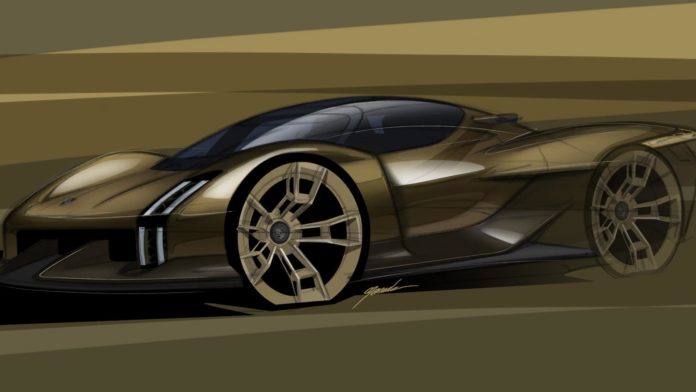To celebrate the opening of the “75 Years of Porsche Sports Cars” exhibit at the Porsche Museum in Stuttgart, the automaker unveiled its latest concept car, the Porsche Mission X, which the company modestly describes as “a spectacular reinterpretation of a hypercar.”
The car debuted June 8, 75 years after the first Porsche 356 Roadster prototype debuted, the first automobile to wear the Porsche name.
“Porsche has only remained Porsche by constantly changing,” said Oliver Blume, chairman of the Executive Board of Porsche AG, in a statement. “The Mission X provides critical impetus for the evolutionary development of future vehicle concepts.”
But the car doesn’t forget the past.
“It picks up the torch of iconic sports cars of decades past: like the 959, the Carrera GT and the 918 Spyder before it,” Blume added.
Body language

That heritage can be seen in the Mission X’s size; it’s kind of small for a hypercar, which have grown in size to match their immense performance. In contrast, the Mission X measures 177 inches long, 78.4 inches wide on a wheelbase of 107.5 inches, or about the size as a Carrera GT or 918 Spyder. They frame a lightweight glass dome supported by a carbon-fiber exoskeleton that covers the car’s cabin, rather than a traditional roof.
And it boasts low-slung body work at a mere 47.2 inches tall.
To enhance aerodynamics, the Mission X wears mixed sized footwear, with 20-inch wheels up front and 21-inch wheels in the rear.

Of course, being a concept car, it can’t boast normal doors, and the Mission X doesn’t disappoint, with Le Mans-style doors attached to the A-pillar and the roof. It’s the first time it’s been used since the legendary Porsche 917 racecar. And LED uses a lighting design inspired by the Porsche 906 and 908 racecars. In the rear, full-width LED lighting is capped by Porsche lettering in the center. While the Mission X is being charged, the letter “E” pulsates. Nice touch.
Designers even modernized the Porsche logo, made of brushed metal to give it a cleaner, modern appearance.
Still, Michael Mauer, head of design for the Porsche Mission X, seems to summarize it best: “The concept study symbolizes a symbiosis of unmistakable motorsport DNA with a luxurious overall impression.”
The inside story

Many vehicles talk about their driver-focused interiors, but not as unmistakably as the Porsche’s Mission X’s cabin. As if to stigmatize the passenger, they have a different Andalusia Brown-colored seat, while the driver’s is colored Kalahari Grey. Both are nestled in carbon-fiber shells, which anchor the six-point safety belts. The open-top, racing-style steering wheel features drive mode switches and shift paddles.
The car also comes equipped with a unique “multipurpose controller.” Much like a video game controller, the trigger-shaped controller features a record button to activate the vehicle’s cameras, while holding the shifter’s trigger button allows you to change gear. It also has a parking button, and the whole controller doubles as a hand rest. On the passenger side, Porsche has designed a space on the instrument panel for mounting a Porsche Design stopwatch that includes both analog and digital readouts.
Powerful Porsche

The company isn’t saying much about the concept’s driveline, besides such vague statements as “should it go into production.” But the company is promising that if it does, it will be the fastest road-legal vehicle around the Nürburgring. Porsche also promises it will have a downforce well beyond those of the current 911 GT3 RS, while its 900-volt architecture will charge twice as quickly as the Porsche Taycan Turbo S.
As if to prove that it can pull such things off, the company points out its past accomplishments with models such as the 959, Carrera GT and 918 Spyder, the latter breaking the seven-minute barrier on the Nürburgring Nordschleife with a time of 6:57.

Certainly, there’s no reason to doubt them.
And while this seems like merely a concept, it’s not too hard to imagine this car at the top of Porsche’s sports car pyramid.
“The Mission X is a clear commitment to the core of the brand. The continuing, enhanced expression of our brand and product identity is an important compass for us to navigate the development of our series-production models,” Mauer said.
Stay tuned; this should get interesting.

